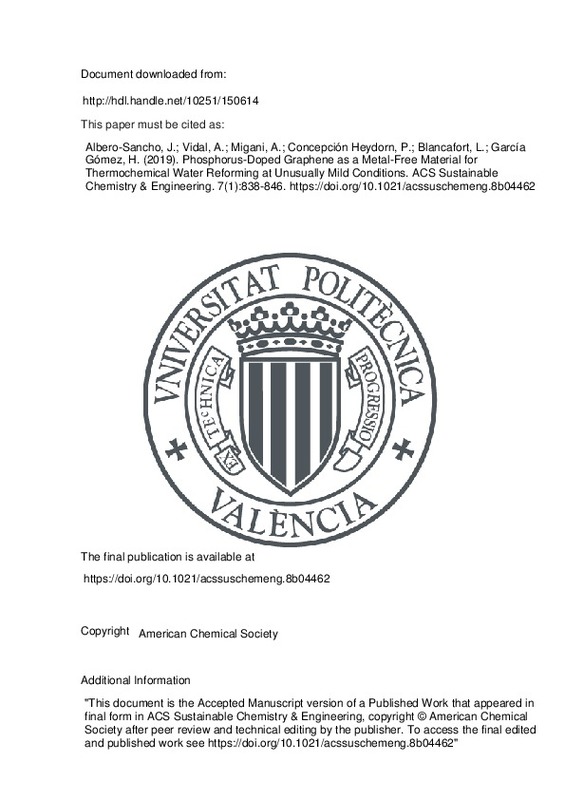Albero-Sancho, J.; Vidal, A.; Migani, A.; Concepción Heydorn, P.; Blancafort, L.; García Gómez, H. (2019). Phosphorus-Doped Graphene as a Metal-Free Material for Thermochemical Water Reforming at Unusually Mild Conditions. ACS Sustainable Chemistry & Engineering. 7(1):838-846. https://doi.org/10.1021/acssuschemeng.8b04462
Por favor, use este identificador para citar o enlazar este ítem: http://hdl.handle.net/10251/150614
|
Título:
|
Phosphorus-Doped Graphene as a Metal-Free Material for Thermochemical Water Reforming at Unusually Mild Conditions
|
|
Autor:
|

 Albero-Sancho, Josep
Vidal, Alfonso
Migani, Annapaola
Albero-Sancho, Josep
Vidal, Alfonso
Migani, Annapaola
 Concepción Heydorn, Patricia
Blancafort, Lluís
Concepción Heydorn, Patricia
Blancafort, Lluís

 García Gómez, Hermenegildo
García Gómez, Hermenegildo
|
|
Entidad UPV:
|
Universitat Politècnica de València. Instituto Universitario Mixto de Tecnología Química - Institut Universitari Mixt de Tecnologia Química
Universitat Politècnica de València. Departamento de Química - Departament de Química
|
|
Fecha difusión:
|
|
|
Resumen:
|
[EN] P-doped graphene (Phy-G) prepared by pyrolysis of phytic acid at 900 degrees C under inert atmosphere has been evaluated as a metal-free catalyst for the thermochemical water splitting. XPS, solid-state P-31 NMR, and ...[+]
[EN] P-doped graphene (Phy-G) prepared by pyrolysis of phytic acid at 900 degrees C under inert atmosphere has been evaluated as a metal-free catalyst for the thermochemical water splitting. XPS, solid-state P-31 NMR, and Raman spectroscopy confirm the presence of P atoms bonded to C atoms in the graphene lattice as well as some oxygenated P groups, such as phosphates or phosphonates. HRTEM and AFM images show the characteristic sheet morphology of 2D graphene materials of several micrometers lateral size and exhibiting a high crystallinity with the characteristic hexagonal arrangement of graphenic materials. Phy-G has been submitted to consecutive oxidation/activation thermochemical cycles at 650 and 800 degrees C under H2O-saturated Ar and dry Ar atmospheres, respectively. During the oxidation periods, H-2 evolution up to 21.6 mu mol/min.g was measured. However, no O-2 evolves in the activation steps. Experimental evidence and computational calculations support the formation of P=O bonds during the oxidation steps. The computational calculations suggest that the thermocatalytic H2O splitting occurs on the P atoms of doped graphene through a stepwise process involving an intermediate with a P-OH group and a H attached to a neighboring C atom and subsequent H-2 evolution, leading to the formation of P-O bonds.
[-]
|
|
Palabras clave:
|
Graphene
,
Phytic acid
,
Thermocatalysis
,
Water reforming
,
Metal-free catalyst
|
|
Derechos de uso:
|
Reserva de todos los derechos
|
|
Fuente:
|
ACS Sustainable Chemistry & Engineering. (issn:
2168-0485
)
|
|
DOI:
|
10.1021/acssuschemeng.8b04462
|
|
Editorial:
|
American Chemical Society
|
|
Versión del editor:
|
https://doi.org/10.1021/acssuschemeng.8b04462
|
|
Código del Proyecto:
|
info:eu-repo/grantAgreement/MINECO//ENE2015-71254-C3-2-R/ES/METODOLOGIA Y CARACTERIZACION DE MATERIALES Y COMPONENTES DE RECEPTORES PARA APLICACIONES SOLARES EN CONDICIONES EXTREMAS/
MINECO/CTQ2015-69563-CO2-1
...[+]
info:eu-repo/grantAgreement/MINECO//ENE2015-71254-C3-2-R/ES/METODOLOGIA Y CARACTERIZACION DE MATERIALES Y COMPONENTES DE RECEPTORES PARA APLICACIONES SOLARES EN CONDICIONES EXTREMAS/
info:eu-repo/grantAgreement/MINECO//CTQ2015-69363-P/ES/OMPUTACION DEL ESTADO EXCITADO: DE ESPECTROS MOLECULARES A SISTEMAS MULTICROMOFORICOS/
info:eu-repo/grantAgreement/Generalitat de Catalunya//2017 SGR 348/
info:eu-repo/grantAgreement/RES//QCM-2017-3-0038/
info:eu-repo/grantAgreement/RES//QCM-2018-1-0037/
info:eu-repo/grantAgreement/MINECO//SEV-2016-0683/
info:eu-repo/grantAgreement/MINECO//CTQ2015-69153-C2-1-R/ES/EXPLOTANDO EL USO DEL GRAFENO EN CATALISIS. USO DEL GRAFENO COMO CARBOCATALIZADOR O COMO SOPORTE/
info:eu-repo/grantAgreement/GVA//PROMETEO%2F2017%2F083/
MINECO/CTQ2015-69563-CO2-1
[-]
|
|
Descripción:
|
"This document is the Accepted Manuscript version of a Published Work that appeared in final form in ACS Sustainable Chemistry & Engineering, copyright © American Chemical Society after peer review and technical editing by the publisher. To access the final edited and published work see https://doi.org/10.1021/acssuschemeng.8b04462"
|
|
Agradecimientos:
|
J.A. and H.G. give thanks for the financial support by the Spanish Ministry of Economy and Competitiveness (Severo Ochoa SEV2016-0683, GRAPAS, and CTQ2015-69563-CO2-1) and Generalitat Valenciana (Prometeo 2017-083). J.A. ...[+]
J.A. and H.G. give thanks for the financial support by the Spanish Ministry of Economy and Competitiveness (Severo Ochoa SEV2016-0683, GRAPAS, and CTQ2015-69563-CO2-1) and Generalitat Valenciana (Prometeo 2017-083). J.A. also thanks UPV for a postdoctoral scholarship. A.V. is grateful to the National Plan for Scientific and Technical Research and Innovation 2013-2016 (ENE2015-71254-C3-2-R) since part of this work has been carried out within the ARROPAR-CEX project. L.B. and A.M. give thanks for the financial support from the Ministry of Economy and Competitiveness (CTQ2015-69363-P). We thank Mr. Pere Creus for carrying out some of the calculations. A.M. gives thanks for the financial support from the Departament d'Innovacio, Universitats i Empresa (DIUE), Generalitat de Catalunya (Project 2017SGR348). Calculations were carried out at the Red Espanola de Supercomputacion (Projects QCM-2017-3-0038 and QCM-2018-1-0037).
[-]
|
|
Tipo:
|
Artículo
|







![[Cerrado]](/themes/UPV/images/candado.png)


